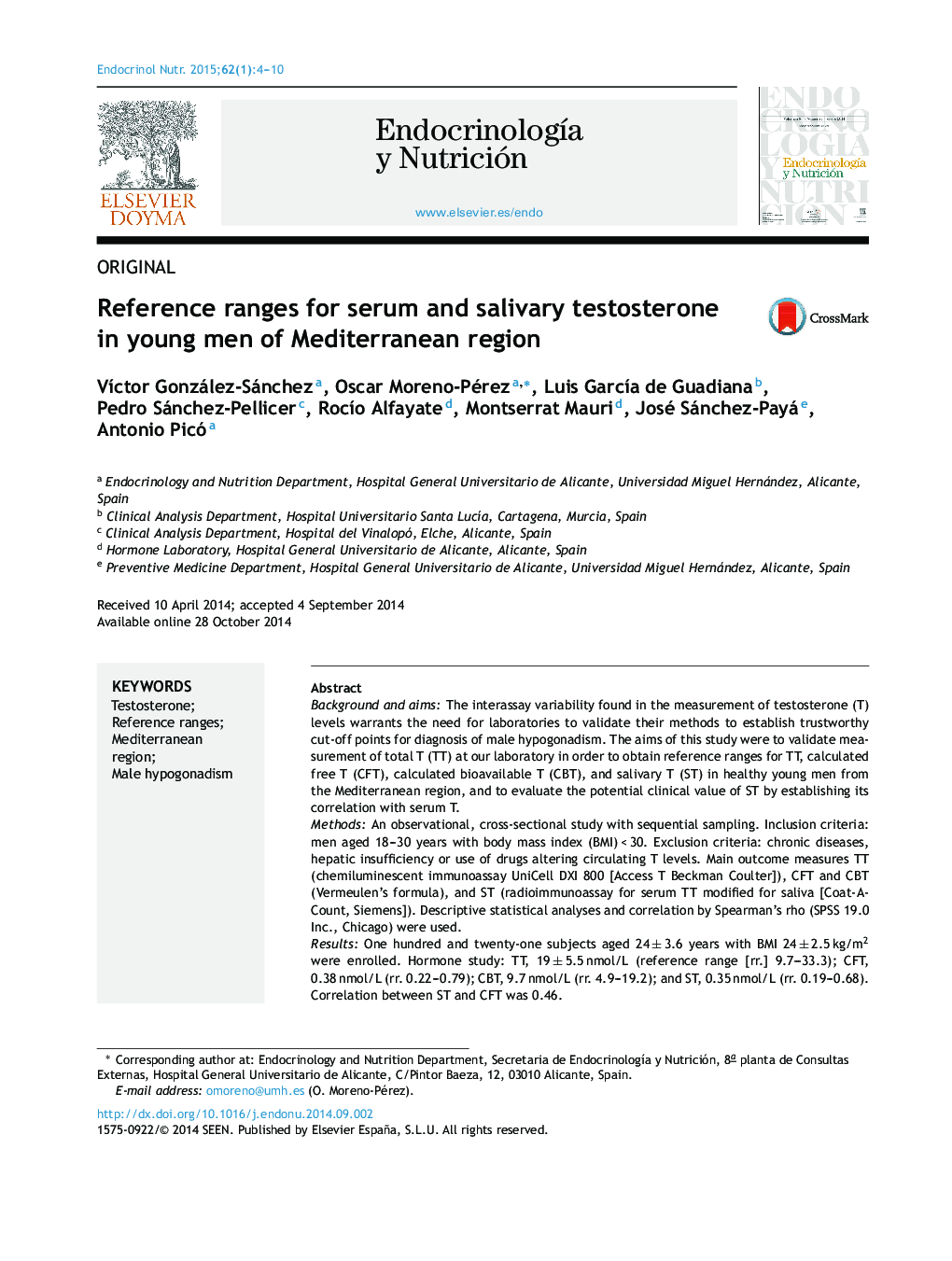| Article ID | Journal | Published Year | Pages | File Type |
|---|---|---|---|---|
| 2773424 | Endocrinología y Nutrición | 2015 | 7 Pages |
Background and aimsThe interassay variability found in the measurement of testosterone (T) levels warrants the need for laboratories to validate their methods to establish trustworthy cut-off points for diagnosis of male hypogonadism. The aims of this study were to validate measurement of total T (TT) at our laboratory in order to obtain reference ranges for TT, calculated free T (CFT), calculated bioavailable T (CBT), and salivary T (ST) in healthy young men from the Mediterranean region, and to evaluate the potential clinical value of ST by establishing its correlation with serum T.MethodsAn observational, cross-sectional study with sequential sampling. Inclusion criteria: men aged 18–30 years with body mass index (BMI) < 30. Exclusion criteria: chronic diseases, hepatic insufficiency or use of drugs altering circulating T levels. Main outcome measures TT (chemiluminescent immunoassay UniCell DXI 800 [Access T Beckman Coulter]), CFT and CBT (Vermeulen's formula), and ST (radioimmunoassay for serum TT modified for saliva [Coat-A-Count, Siemens]). Descriptive statistical analyses and correlation by Spearman's rho (SPSS 19.0 Inc., Chicago) were used.ResultsOne hundred and twenty-one subjects aged 24 ± 3.6 years with BMI 24 ± 2.5 kg/m2 were enrolled. Hormone study: TT, 19 ± 5.5 nmol/L (reference range [rr.] 9.7–33.3); CFT, 0.38 nmol/L (rr. 0.22–0.79); CBT, 9.7 nmol/L (rr. 4.9–19.2); and ST, 0.35 nmol/L (rr. 0.19–0.68). Correlation between ST and CFT was 0.46.ConclusionsIn men from the Mediterranean region, values of TT > 9.7 nmol/L, CFT > 0.22 nmol/L, and/or CBT > 4.9 nmol/L make the presence of biochemical hypogonadism unlikely. According to the correlation between serum and ST, the clinical value of ST remains to be established.
ResumenAntecedentes y objetivosLa variabilidad interensayo existente en la determinación de testosterona (T) justifica la necesidad de que cada laboratorio valide su método y establezca puntos de corte fiables para el diagnóstico del hipogonadismo masculino. Los objetivos del estudio fueron validar la determinación de T total (TT) en nuestro laboratorio para obtener los valores de referencia de TT, T libre calculada (TLC), T biodisponible calculada (TBC) y T salivar (TS) en varones jóvenes sanos del área mediterránea y evaluar la posible utilidad clínica de la TS.Material y métodosEstudio observacional transversal. Muestreo secuencial. Criterios de inclusión: varones, 18–30 años de edad, índice de masa corporal (IMC) < 30. Criterios de exclusión: enfermedades crónicas, insuficiencia hepática o uso de medicamentos que alteran las concentraciones circulantes de T. Metodología: TT (inmunoanálisis de quimioluminiscencia UniCell DXI800 [Acces T Beckman Coulter]), TLC y TBC (fórmula de Vermeulen), TS (radioinmunoensayo para TT sérica modificado para la saliva [Coat-A-Count, Siemens]). Análisis estadísticos: descriptivos y correlación rho de Spearman (SPSS 19,0 Inc.,Chicago).ResultadosSe incluyeron 121 individuos de 24 ± 3,6 años e IMC 24 ± 2,5 kg/m2. Estudio hormonal TT, 19 ± 5,5 nmol/L (intervalo de confianza 95% 9,7–33,3); TLC, 0,38 nmol/L ([P2,5–P97,5] 0,22–0,79); TBC, 9,7 nmol/L ([P2,5–P97,5] 4,9–19,2); y TS, 0,35 nmol/L ([P2,5–P97,5] 0,19–0,68). La correlación entre TS y TLC fue 0,46.ConclusionesEn varones de la región mediterránea, concentraciones de TT > 9,7 nmol/L, TLC > 0,22 nmol/L y/o TBC > 4,9 nmol/L hacen improbable la presencia de hipogonadismo bioquímico. De acuerdo a la correlación entre la testosterona sérica y salivar, la utilidad clínica de la ST está aún por establecerse.
